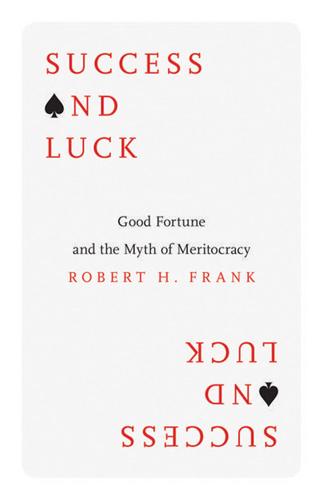
Success and Luck: Good Fortune and the Myth of Meritocracy
by
Robert H. Frank
Published 31 Mar 2016
Watts illustrates his point with the interesting history of the Mona Lisa, easily the most famous painting in the world. During a visit to the Louvre, he noticed the ubiquitous throngs jostling for a closer look at the painting, even as several other canvases by Leonardo da Vinci from the same era went almost completely ignored in an adjacent gallery. To Watts, the Mona Lisa seemed no better than those other paintings. Curious, he did a little digging and discovered that it had languished in obscurity for most of its early life. What pushed the painting into the spotlight was apparently its theft in 1911 by Vincenzo Peruggia, an Italian maintenance worker at the Louvre who tucked it under his smock before leaving work one evening.
…
The Italians hailed Peruggia as a patriot who wanted to return the painting home. Newspapers around the world reproduced it, making it the first work of art to achieve global fame. From then on, the “Mona Lisa” came to represent Western culture itself.3 As Watts writes, “We claim to be saying that the Mona Lisa is the most famous painting in the world because it has attributes X, Y and Z. But really what we’re saying is that the Mona Lisa is famous because it’s more like the Mona Lisa than anything else.”4 Consider also the career of Al Pacino, one of the most celebrated actors of the past forty years. Fans may find it difficult to imagine an alternative version of history in which he did not succeed as an actor.
…
But it has instilled in me a keen interest in the subject and has stimulated me to learn much more about it than I otherwise would have. My personal experiences with chance events in the labor market have also spurred me to learn more about how such events shape career trajectories. The influence of even seemingly minor random events is often profound. Is the Mona Lisa special? Is Kim Kardashian? They’re both famous, but sometimes things are famous just for being famous. Although we often try to explain their success by scrutinizing their objective qualities, they are in fact often no more special than many of their less renowned counterparts. Ahead I’ll describe how success often results from positive feedback loops that amplify tiny initial variations into enormous differences in final outcomes.

The Truth About Lies: The Illusion of Honesty and the Evolution of Deceit
by
Aja Raden
Published 10 May 2021
What if the Mona Lisa is only the Mona Lisa because everyone agrees it is? In 1911, a man named Vincenzo Peruggia, an Italian janitor at the Louvre Museum in Paris, took the famous painting from its frame and simply walked out with it under his smock. He hid it at home, in the false bottom of a trunk, for the next two years. Having gotten away with the crime of the century, Peruggia then (for no apparent reason at all) took the painting back to Italy, where he brazenly presented the stolen painting for sale to the directors of the Uffizi Gallery in Florence. He was, of course, arrested and the painting was returned to Paris on January 4, 1914. He claimed the theft was an act of patriotism—which never made much sense, because the Louvre was full of paintings by Italian masters, many more famous or more valuable than the Mona Lisa at that time—and ultimately he went to prison for about six months.3 That’s the part of the story of the infamous theft of the Mona Lisa that everyone knows.
…
And if no one can tell the difference—how can you be so sure that there even is one, let alone so certain that it matters? Many Lisas The Mona Lisa by Leonardo da Vinci is arguably the most famous painting in the world. It’s inarguably a masterpiece, so I’m told. And I went to art school. Sure, everyone who goes and sees it comes home and says, “Well … it was a lot smaller than I thought,” and seems sort of underwhelmed. Nonetheless, over six million people flock to the Louvre to see the Mona Lisa every year. One could make the argument that the Mona Lisa is only a masterpiece because everyone agrees it is so. But let’s skip over that for now. What if the Mona Lisa is only the Mona Lisa because everyone agrees it is?
…
He claimed the theft was an act of patriotism—which never made much sense, because the Louvre was full of paintings by Italian masters, many more famous or more valuable than the Mona Lisa at that time—and ultimately he went to prison for about six months.3 That’s the part of the story of the infamous theft of the Mona Lisa that everyone knows. Here’s the part they don’t: in 1908, several years before the Mona Lisa was stolen, an Argentine art swindler, Eduardo de Valfierno, used multiple aliases to gain entry to the United States and obtain access to certain exclusive circles in society. He managed to gain the trust of a number of millionaire art collectors, all of them not only wealthy but also possessed of a certain amount of moral flexibility.

Everything Is Obvious: *Once You Know the Answer
by
Duncan J. Watts
Published 28 Mar 2011
And admired as he was, up until the 1850s, da Vinci was considered no match for the true greats of painting, like Titian and Rafael, some of whose works were worth almost ten times as much as the Mona Lisa. In fact, it wasn’t until the twentieth century that the Mona Lisa began its meteoric rise to global brand name. And even then it wasn’t the result of art critics suddenly appreciating the genius that had sat among them for so long, nor was it due to the efforts of museum curators, socialites, wealthy patrons, politicians, or kings. Rather, it all began with a burglary. On August 21, 1911, a disgruntled Louvre employee named Vincenzo Peruggia hid in a broom closet until closing time and then walked out of the museum with the Mona Lisa tucked under his coat. A proud Italian, Peruggia apparently believed that the Mona Lisa ought rightly to be displayed in Italy, not France, and he was determined to repatriate the long-lost treasure personally.
…
This last point presents a problem because when we try to explain the success of the Mona Lisa, it is precisely its attributes on which we focus our attention. If you’re Kenneth Clark, you don’t need to know anything about the circumstances of the Mona Lisa’s rise to fame to know why it happened—everything you need to know is right there in front of you. To oversimplify only slightly, the Mona Lisa is the most famous painting in the world because it is the best, and although it might have taken us a while to figure this out, it was inevitable that we would. And that’s why so many people are puzzled when they first actually set eyes on the Mona Lisa. They’re expecting these intrinsic qualities to be apparent, and they’re not.
…
As Sassoon points out, all these different people—thieves, vandals, artists, and advertisers, not to mention musicians, moviemakers, and even NASA (remember the crater on Venus?)—were using the Mona Lisa for their own purposes: to make a point, to increase their own fame, or simply to use a label they felt would convey meaning to other people. But every time they used the Mona Lisa, it used them back, insinuating itself deeper into the fabric of Western culture and the awareness of billions of people. It is impossible now to imagine the history of Western art without the Mona Lisa, and in that sense it truly is the greatest of paintings. But it is also impossible to attribute its unique status to anything about the painting itself.

Hit Makers: The Science of Popularity in an Age of Distraction
by
Derek Thompson
Published 7 Feb 2017
The historian Donald Sassoon reported that, in 1849, the Mona Lisa was valued at 90,000 francs. That’s a tidy sum, but not even close to Titian’s Supper at Emmaus (150,000 francs at the time) or Raphael’s The Holy Family (600,000 francs), which hung in the same museum. The Mona Lisa’s fame got an assist from a dim-witted thief. On August 11, 1911, a Monday, Vincenzo Peruggia, an unemployed Italian painter, walked into the Louvre and left with the Mona Lisa. French newspapers were aghast at the theft and indignantly proclaimed the painting’s historic significance. The Mona Lisa went missing for several years, until Peruggia—stuck with an expensive artwork whose sale would inevitably lead to his apprehension—tried to hawk the painting in Florence and was duly apprehended.
…
The recovery of the Mona Lisa and its return to France was an international sensation. Several years after the painting’s recovery, in 1919, the modernist Marcel Duchamp made a replica of the Mona Lisa with a mustache. He called it L.H.O.O.Q., which, if you pronounce the letters in French, is a homophone for something naughty.41 Defiling the placid smile of the Mona Lisa struck a lot of other painters as an inexhaustibly funny idea. So in the last century some of the most famous painters—including Jasper Johns, Robert Rauschenberg, René Magritte, Salvador Dalí, and Andy Warhol—made their own Mona Lisa parodies.
…
One reason why I like Watts—even though, in our meeting, he relished poking holes in some of my theories—is that he is completely unsentimental about why some products succeed, and he’s very good at explaining the pitfalls of sentimental explanations. One of his best attacks on wooly-headed thinking is his take on the Mona Lisa as the most popular painting in the world. Today there is little doubt about the rarefied air of Leonardo da Vinci’s portrait. The Mona Lisa is the world’s most treasured painting, literally: It holds the Guinness World Record for the most expensive insurance policy on any art piece. In 1973, the art critic Kenneth Clark called the Mona Lisa the “supreme example of perfection,” saying it deserved its title as the most famous painting in the world. But in the nineteenth century, it wasn’t even the most famous painting in its museum, the Louvre in Paris.